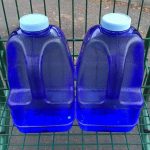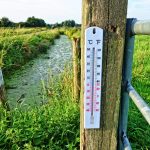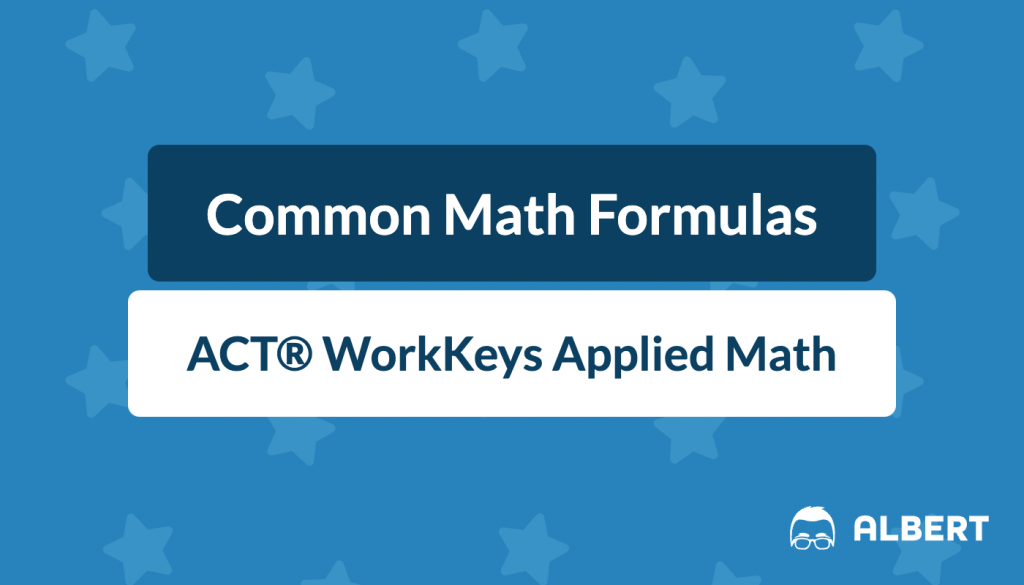The ACT® WorkKeys Applied Math test challenges you to solve real-world math problems using common math formulas. From converting units to calculating areas and volumes, these formulas are essential for the test and practical work scenarios. Understanding when and how to use these formulas will make tackling problems quickly and accurately easier. This guide covers the most common math formulas you’ll need to know, helping you prepare for the ACT® Workkeys Applied Math exam and improve your math skills for everyday tasks.
Common Math Formulas: Unit Conversions
Conversions are a big part of the ACT® WorkKeys Applied Math test. You’ll often need to switch between different units for distance, volume, weight, and temperature. Understanding how to convert between these units can help you solve problems more quickly and accurately.
Distance Conversions
Distance conversions are useful when measuring or comparing lengths in different units, such as feet, inches, or meters. Here are some key distance conversion formulas you should know:
- Feet and Inches: 1 \text{ foot} = 12 \text{ inches}
- Yards and Feet: 1 \text{ yard} = 3 \text{ feet}
- Miles and Feet: 1 \text{ mile} = 5{,}280 \text{ feet}
- Inches and Centimeters: 1 \text{ inch} = 2.54 \text{ centimeters}
- Kilometers and Miles: 1 \text{ kilometer} \approx 0.62 \text{ miles}
For example, if you need to measure a room that is 15\text{ feet} long and convert it to inches, you would multiply the number of feet by 12 (since 1\text{ foot} = 12\text{ inches}):
15 \text{ feet} \times 12 \text{ inches} = 180 \text{ inches}
Area Conversions
Area conversions help you calculate how much space something covers, such as the size of a floor or a plot of land. You might be asked to switch between square feet, square yards, or even acres.
- Square Feet and Square Inches: 1 \text{ square foot} = 144 \text{ square inches}
- Acres and Square Feet: 1 \text{ acre} = 43{,}560 \text{ square feet}
Let’s see how to use this in an example. If you have 500\text{ square feet} of land and need to know how many acres that is, divide the square feet by the number of square feet in an acre (43{,}560):
\frac{500 \text{ square feet}}{43{,}560 \text{ square feet/acre}} = 0.0115 \text{ acres}
Volume Conversions
Volume conversions are common in jobs that involve measuring liquids or filling containers. You’ll often convert between gallons, quarts, or cubic inches.
- Cups and Fluid Ounces: 1 \text{ cup} = 8 \text{ fluid ounces}
- Quarts and Cups: 1 \text{ quart} = 4 \text{ cups}
- Gallons and Quarts: 1 \text{ gallon} = 4 \text{ quarts}
- Cubic Feet and Cubic Inches: 1 \text{ cubic foot} = 1{,}728 \text{ cubic inches}

So, if a tank holds 16\text{ quarts}, how many gallons is that? Divide the number of quarts by 4 (since 1\text{ gallon} = 4\text{ quarts}).
\frac{16 \text{ quarts}}{4 \text{ quarts/gallon}} = 4 \text{ gallons}
Weight Conversions
Weight conversions are needed when working with measurements like pounds, kilograms, or ounces.
- Pounds and Ounces: 1 \text{ pound} = 16 \text{ ounces}
- Kilograms and Pounds: 1 \text{ kilogram} \approx 2.2 \text{ pounds}
For example, if you have a shipment that weighs 32\text{ ounces}, how many pounds is that? Divide the ounces by 16 (since 1\text{ pound} = 16\text{ ounces}):
\frac{32 \text{ ounces}}{16 \text{ ounces/pound}} = 2 \text{ pounds}
Common Math Formulas: Geometry
Geometry is another key part of the ACT® WorkKeys Applied Math test. You must often solve problems involving shapes, areas, and volumes. These common math formulas can help you calculate measurements for rectangles, triangles, and circles. Knowing these formulas is essential for practical, real-life tasks.
Rectangle Formulas
Rectangles are everywhere, from room layouts to construction materials. To solve geometry problems related to rectangles, you must know how to calculate perimeter and area.
- Perimeter of a Rectangle: \text{Perimeter} = 2 \times (\text{length} + \text{width})
- Area of a Rectangle: \text{Area} = \text{length} \times \text{width}

Example: You are asked to find the perimeter and area of a room that is 10\text{ feet} long and 12\text{ feet} wide.
Solution (Perimeter): \text{Perimeter} = 2 \times (10 + 12) = 2 \times 22 = 44 \text{ feet}
Solution (Area): \text{Area} = 10 \times 12 = 120 \text{ square feet}
Triangle Formulas
Triangles appear in problems related to building structures or objects with angled sides. The key formula for triangles is the area calculation.
- Area of a Triangle: \text{Area} = \frac{1}{2} \times \text{base} \times \text{height}
For example, you need to find the area of a triangular piece of land with a base of 8\text{ feet} and a height of 5\text{ feet}.
Solution: \text{Area} = \frac{1}{2} \times 8 \times 5 = 20 \text{ square feet}
Circle Formulas
Circles show up in problems involving round objects like pipes, wheels, or plates. You’ll need to know how to calculate the circumference (distance around the circle) and the area (space inside the circle).
- Circumference of a Circle: \text{Circumference} \approx 3.14 \times \text{diameter}
- Area of a Circle: \text{Area} \approx 3.14 \times (\text{radius})^2
Let’s say you are asked to find the circumference and area of a circle with a radius of 7\text{ inches}.
Solution (Circumference): \text{Circumference} \approx 3.14 \times (2 \times 7) = 3.14 \times 14 = 43.96 \text{ inches}
Solution (Area): \text{Area} \approx 3.14 \times 7^2 = 3.14 \times 49 = 153.86 \text{ square inches}
Volume of a Rectangular Solid (Box)
You’ll often face problems that require you to calculate the volume of a box or container. This is common in tasks like packing or shipping.
- Volume of a Rectangular Solid: \text{Volume} = \text{length} \times \text{width} \times \text{height}
Let’s try this as an example. You are asked to find the volume of a box that is 3\text{ feet} long, 2\text{ feet} wide, and 4\text{ feet} high.
- Solution: \text{Volume} = 3 \times 2 \times 4 = 24 \text{ cubic feet}
Common Math Formulas: Applied Science
In the ACT® WorkKeys Applied Math section, you may encounter science-related like electricity, temperature, and energy. These formulas are important in jobs that deal with things like electrical systems, temperature control, or energy use.
Electricity Formulas
Electrical formulas help you calculate the flow of electricity, which is especially useful in jobs involving machinery, wiring, or energy consumption. Two fundamental formulas you need to know are for calculating amps and kilowatt-hours.
- Amps Formula: \text{Amps} = \frac{\text{Watts}}{\text{Volts}}
- This formula helps you determine the amount of electrical current (amps) in a circuit when you know the power (watts) and the voltage (volts).
- Kilowatt-Hour Formula: 1 \text{ kilowatt-hour} = 1{,}000 \text{ watt-hours}
- This formula measures energy consumption over time, such as the amount of electricity a machine or household uses.
For example, you have an appliance that uses 600\text{ watts} and is connected to a 120\text{-volt} outlet. How many amps does it use?
\text{Amps} = \frac{600 \text{ watts}}{120 \text{ volts}} = 5 \text{ amps}
This means the appliance draws 5\text{ amps} of electrical current.
Temperature Conversions
Temperature conversions are essential in heating, cooling, or scientific jobs. The ACT® WorkKeys applied math test may ask you to convert between Fahrenheit (^\circ\text{F}) and Celsius (^\circ\text{C}).

- Fahrenheit to Celsius: ^\circ\text{C} = 0.56 \times (^\circ\text{F} - 32)
- Celsius to Fahrenheit: ^\circ\text{F} = 1.8 \times (^\circ\text{C}) + 32
If the temperature in a room is 68^\circ\text{F}, what is the temperature in Celsius? Use the Fahrenheit to Celsius formula:
^\circ\text{C} = 0.56 \times (68 - 32)
^\circ\text{C} = 0.56 \times 36 = 20^\circ\text{C}
Conclusion
Mastering these common math formulas is key to succeeding on the ACT® WorkKeys Applied Math test. Whether you’re converting measurements, calculating areas and volumes, or solving science-related problems, knowing how to apply these formulas will save you time and improve your accuracy. Remember to practice regularly, using real-world examples to reinforce your understanding. By getting comfortable with these formulas, you’ll be better equipped for the test and real-life job situations requiring math skills.
Need help preparing for the ACT® WorkKeys Applied Math Test?
Albert has hundreds of ACT® WorkKeys practice questions and full-length practice tests to try out.








